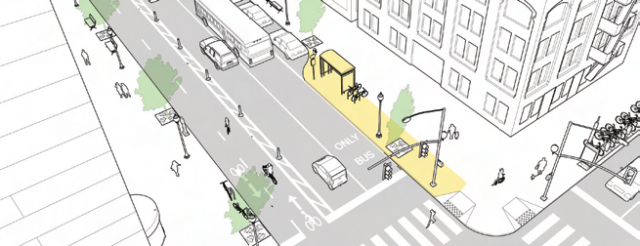Over the coming century, the challenges borne by cities and the burdens placed upon their streets will multiply in quantity and complexity. Growing urban populations will demand that their streets serve not only as corridors for the conveyance of people, goods, and services, but as front yards, parks, playgrounds, and public spaces. Streets must accommodate an ever-expanding set of needs. They must be safe, sustainable, resilient, multi-modal, and economically beneficial, all while accommodating traffic.
In response to these unprecedented demands, cities around the country are developing an innovative body of practice and expertise to design for and around the special characteristics of the urban environment. From New York’s Times Square to Chicago’s Wacker Drive to Spring Street in Los Angeles, a better approach to an understanding of street design is taking root in our cities.
Using the Guide
The contents of this guide have been formatted so that a reader may engage with the material in a nonlinear fashion. While each section provides varying degrees of detail and information, these sections present individual topics which do not require a complete reading of the material that precedes it.
Relation to Other National, State, and Local Design Guidelines
The Urban Street Design Guide focuses on the design of city streets and public spaces. While other national manuals, such as AASHTO’s A Policy on Geometric Design of Highways and Streets, provide a general discussion of street design in an urban context, the Urban Street Design Guide emphasizes city street design as a unique practice with its own set of design goals, parameters, and tools.
In instances where a particular sign or marking should be used, the guide highlights its specific reference to the Manual for Uniform Traffic Control Devices (MUTCD).
Many cities have already gone through the process of developing a local street design manual in the interest of creating internal design consensus between different local agencies. NACTO references materials from a selection of these guides and urges municipalities to use the Urban Street Design Guide as a basis for the creation of local standards.
It is important to note that urban situations are complex. The treatments and topics discussed in this guide must be tailored to individual situations and contexts. NACTO encourages good engineering judgment in all cases. Decisions should be thoroughly documented. To assist with this, this guide links to references and cites relevant materials and studies.
Certain sections of the guide reference material in its companion document, the Urban Bikeway Design Guide (2nd edition), which may be accessed online at c4cguide.org.
Levels of Guidance
 For most topics and treatments in this guide, the reader will find three levels of guidance.
For most topics and treatments in this guide, the reader will find three levels of guidance.
Critical Features are elements for which there is a strong consensus of absolute necessity.
Recommended Features are elements for which there is a strong consensus of added added value.
Optional Features are elements that may vary across cities and may add value, depending on the situation.
Note: Certain sections contain a general discussion only and have no critical, recommended, or optional points. Key points on renderings are highlighted in yellow. Highlights either refer to the treatment or topic being discussed or to the main thrust of the image shown.